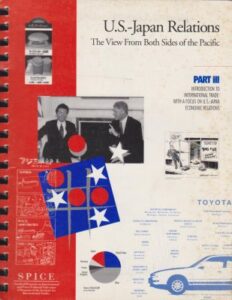Part III: Introduction to International Trade: with a focus on U.S.-Japan Economic Relations
 SPICE, INSTITUTE FOR INTERNATIONAL STUDIES
SPICE, INSTITUTE FOR INTERNATIONAL STUDIES
LITTLEFIELD CENTER, ROOM 14
STANFORD UNIVERSITY
300 LAUSEN STREET
STANFORD, CA 94305-5013
Reviewed by James Mak
What should 10th to 12th graders know about international trade? The Stanford Program on International and Cross-Cultural Education (SPICE) has developed a nice package of five lessons on international trade with a focus on U.S.-Japan economic relations.
The developers of this curriculum unit, Gary Mukai and Truc Truong, selected five topics: (1) the meaning of economic interdependence; (2) the “process of
trade” and how exchange rates influence trade; (3) the benefits of trade, with a focus on absolute and comparative advantage; (4) the problems of trade,
with a focus on the economics of protectionism; and (5) perspectives on the future of U.S. and Japan trade relationship with messages from a former U.S.
ambassador to Japan and the Japanese ambassador to the U.S.
This is not simply a collection of chapters on international trade from a standard beginning economics textbook. It is designed as a collection of active learning modules with many interactive
activities for small groups of students, a crossword puzzle, cartoons and comic strips, and some problem-solving exercises. By working through these activities either in small groups or individually, students discover for themselves the importance and the meaning of some of the most basic principals of international trade. Focusing on U.S.-Japan trade relationships has
the advantage of making international trade much less abstract. Students won’t find these lessons boring.
Nonetheless, I see this unit most effectively used as a supplement in a high school economics course in tandem with a standard introductory textbook. Indeed, this is the recommendation given to Hawaii’s high school economics and social studies teachers by the Center for Economic Education at the University of Hawaii at Manoa.
Students can also get more out of these lessons if their teacher has knowledge of the Japanese economy and society. For example, my personal favorite is the lesson on economic interdependence. The module contains responses from thirty Japanese high school students on such questions as “What is your favorite American food?” “What classes are you taking at school?” “Can you list some imported products that you use or see being used in Japan?” “Are there any products you know that exist in the United States that you wish were available in Japan?” “How do you feel about trading between the United States and Japan?” I am sure that many American students will find some of the responses as curious and interesting as I did, and they will no doubt have questions for their teachers. Japanese students were impressed by long summer vacations in America (why do Japanese have short summer vacations?); large houses and yards (why do Japanese have small homes?); big land and parks in the U.S. (how does Japan compare?); the ability of American students to pick their classes (why don’t Japanese students have the choice of classes to take?), and so forth. The numerous comments from Japanese high school students on Japan’s rice import policy might also spark many questions from American students. It would be interesting to hear comments from teachers who have used this curriculum unit about the kinds of questions American students asked in class, and how the American teachers answered.
For teachers who might be interested in learning more about Japanese society and economy, they might find two recently published books useful; one by sociologist Yukio Sugimoto, An Introduction to Japanese Society published in 1997 by Cambridge University Press, and the other co-edited by James Mak, Shyam Sunder, Shigeyuki Abe, and Kazuhiro Igawa, Japan: Why It Works, Why It Doesn’t, Economics in Everyday Life published in 1998 by the University of Hawaii Press.
There is one minor weakness in this curriculum unit in the discussion of the “process of trade” (Lesson #2). Unfortunately, this term was never precisely defined. It is unclear whether the authors meant the five steps that people must go through (e.g. find and contact potential customers, negotiate terms of agreement, etc.) in order to buy/sell between countries or that there are different ways of doing business in Japan and in the U.S. To add to the confusion, Lesson #4, page 118, Question #1 refers to a “process of trade diagram” in Lesson #2; but there is no diagram with that title.
Finally, a curriculum unit that relies heavily on current events tends to have a short shelf-life. This fine unit was published in 1994 and should be updated soon.

